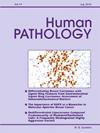tfe3重排骨化纤维黏液样肿瘤糖蛋白非转移性黑色素瘤蛋白B呈独特阴性:13例tfe3重排间充质肿瘤的研究
IF 2.7
2区 医学
Q2 PATHOLOGY
引用次数: 0
摘要
目的:糖蛋白非转移性黑色素瘤蛋白B (GPNMB)是MiTF/TFE3的转录靶点。先前的研究表明,GPNMB免疫组化对TSC1/TSC2/MTOR、TFE3和TFEB基因改变的肾细胞癌以及肺泡软部肉瘤(ASPS)和血管周围上皮样细胞瘤(PEComas)是一种敏感的筛查工具。然而,GPNMB在一组分子证实的tfe3重排间充质肿瘤中的表达尚未得到系统评估。方法:我们查阅了之前用RNA NGS面板评估的tfe3重排非肾肿瘤档案。对于每个病例,对整个切片进行GPNMB免疫染色,并使用h评分进行量化。纳入的肿瘤类型的甲基化谱从我们的数据库中检索。结果:共发现13例TFE3重排肿瘤,包括6例骨化性纤维黏液样肿瘤(OFMTs) (PHF1::TFE3), 3例PEComas/ pecoma样肿瘤(ASPSCR1::TFE3, DVL2::TFE3, PRCC::TFE3,各1例),2例YAP1::TFE3重排血管内皮瘤,1例ASPSCR1::TFE3), 1例未分类的CBX4::TFE3重排肉瘤。以ASPSCR1、PRCC、YAP1和DVL2为融合伴侣的肿瘤的平均h评分分别为300、300、290和280。所有6例PHF1::TFE3重排的ofmt和CBX4::TFE3重排的肉瘤均为gpnmb阴性,尽管与阳性病例具有相似的TFE3断点(外显子6-7)。与ASPS相比,PHF1:: tfe3重排的OFMT显示GPNMB启动子位点cg02203656的相对高甲基化(p=0.027)。结论:虽然需要对其他病例进行研究,但这些发现表明,与其他已知的tfe3重排肿瘤相比,tfe3重排的下游效应在PHF1:: tfe3重排的OFMTs中有所不同。tfe3重排的ofmt在表观遗传上是不同的,这意味着tfe3重排的影响可能是谱系依赖的。本文章由计算机程序翻译,如有差异,请以英文原文为准。
TFE3-rearranged ossifying fibromyxoid tumors are uniquely negative for glycoprotein non-metastatic melanoma protein B: A study of 13 TFE3-rearranged mesenchymal tumors
Objectives
Glycoprotein non-metastatic melanoma protein B (GPNMB) is a transcriptional target of MiTF/TFE3. Prior studies have shown that immunohistochemistry for GPNMB is a sensitive screening tool for renal cell carcinomas with alterations of TSC1/TSC2/MTOR, TFE3, and TFEB genes, as well as alveolar soft part sarcomas (ASPS) and perivascular epithelioid cell neoplasms (PEComas). However, GPNMB expression has not been systematically evaluated in a diverse group of molecularly confirmed, TFE3-rearranged mesenchymal tumors.
Methods
Our archive was interrogated for TFE3-rearranged non-renal neoplasms previously assessed with our RNA NGS panel. For each case, a whole-slide section was immunostained for GPNMB, and quantified using H-scores. The methylation profiles of the included tumor types were retrieved from our database.
Results
Thirteen TFE3-rearranged tumors were identified, including 6 ossifying fibromyxoid tumors (OFMTs) (PHF1::TFE3), 3 PEComas/PEComa-like neoplasms (ASPSCR1::TFE3, DVL2::TFE3, and PRCC::TFE3, one case each), 2 YAP1::TFE3-rearranged hemangioendotheliomas, one ASPS (ASPSCR1::TFE3), and one unclassified CBX4::TFE3-rearranged sarcoma. Tumors harboring ASPSCR1, PRCC, YAP1, and DVL2 as the fusion partner had a mean H-score of 300, 300, 290 and 280, respectively. All 6 PHF1::TFE3-rearranged OFMTs and the CBX4::TFE3-rearranged sarcoma were GPNMB-negative, despite having similar TFE3 breakpoints to the positive cases (exon 6–7). PHF1::TFE3-rearranged OFMT showed relative hypermethylation of the GPNMB promoter locus cg02203656 compared to ASPS (p = 0.027).
Conclusions
Although study of additional cases is necessary, these findings suggest that the downstream effects of TFE3-rearrangement are different in PHF1::TFE3-rearranged OFMTs, compared to other known TFE3-rearranged neoplasms. TFE3-rearranged OFMTs are epigenetically distinct, implying that the impact of TFE3-rearrangement may be lineage-dependent.
求助全文
通过发布文献求助,成功后即可免费获取论文全文。
去求助
来源期刊

Human pathology
医学-病理学
CiteScore
5.30
自引率
6.10%
发文量
206
审稿时长
21 days
期刊介绍:
Human Pathology is designed to bring information of clinicopathologic significance to human disease to the laboratory and clinical physician. It presents information drawn from morphologic and clinical laboratory studies with direct relevance to the understanding of human diseases. Papers published concern morphologic and clinicopathologic observations, reviews of diseases, analyses of problems in pathology, significant collections of case material and advances in concepts or techniques of value in the analysis and diagnosis of disease. Theoretical and experimental pathology and molecular biology pertinent to human disease are included. This critical journal is well illustrated with exceptional reproductions of photomicrographs and microscopic anatomy.
 求助内容:
求助内容: 应助结果提醒方式:
应助结果提醒方式:


